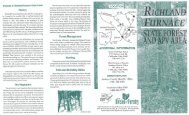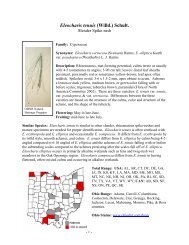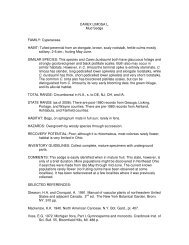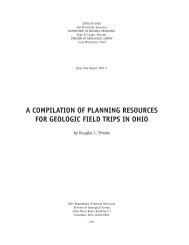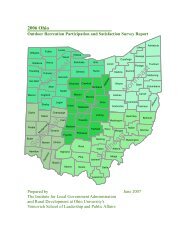Owls of Ohio - Ohio Department of Natural Resources
Owls of Ohio - Ohio Department of Natural Resources
Owls of Ohio - Ohio Department of Natural Resources
You also want an ePaper? Increase the reach of your titles
YUMPU automatically turns print PDFs into web optimized ePapers that Google loves.
N e s ting long - e a re d o w lLong-eared owls use the abandoned stick nests <strong>of</strong>other birds almost exclusively. Host species includethe red-tailed hawk, Cooper’s hawk, and Americancrow. The latter two species are probably the mostfrequent nest donors <strong>of</strong> <strong>Ohio</strong>-nesting long-earedowls.Pairs probably form sometime after winter roostsdisband, and eggs are laid in March or April.Most clutches contain five or six eggs, and theseare incubated exclusively by the female. Hatchingoccurs at about 28 days, and the young remainin the nest for about three weeks. The owlets aresometimes referred to as “branchers,” as whenthey depart the nest they remain in nearby treesand move around by climbing about branchesusing their bill and talons. They begin to fly aboutfive weeks after hatching.A wintering owl “hotspot” at Killdeer Plains Wildlife Area in WyandotCounty. This is a mature planting <strong>of</strong> white pine within a large area<strong>of</strong> open fields that attracts many raptors. Both long-eared owls andNorthern saw-whet owls are <strong>of</strong>ten found roosting in these pines.C O M M O N O W L S O F O H I O 33Vo c aliz ati o n s l o ng - e a re d o w lThese owls very seldom call away from activenest sites. The typical advertising song, given by themale and the most commonly heard vocalization, isa series <strong>of</strong> deep uniform hoots, spaced a few secondsapart. Females give a nest call during the earlypart <strong>of</strong> the breeding season; this is a rather nasalsoundinghoot, and may be given in response to themale’s hoots.Displaying males <strong>of</strong>ten clap their wings duringcourtship; this sound is surprisingly loud and soundssomewhat like hands being clapped together. Like allowls, long-eareds can create loud clicks by snappingtheir bills when disturbed.Long-eared owl pelletsPhoto by: ©Gary MeszarosPhoto by: ODNR Division <strong>of</strong> Wildlife / Jim McCormac



